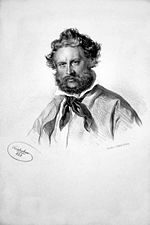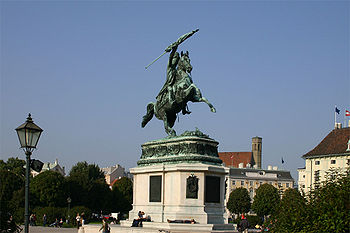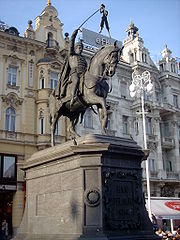
Anton Dominik Fernkorn
Encyclopedia



Erfurt
Erfurt is the capital city of Thuringia and the main city nearest to the geographical centre of Germany, located 100 km SW of Leipzig, 150 km N of Nuremberg and 180 km SE of Hannover. Erfurt Airport can be reached by plane via Munich. It lies in the southern part of the Thuringian...
- November 16, 1878, Vienna
Vienna
Vienna is the capital and largest city of the Republic of Austria and one of the nine states of Austria. Vienna is Austria's primary city, with a population of about 1.723 million , and is by far the largest city in Austria, as well as its cultural, economic, and political centre...
) was a German-Austria
Austria
Austria , officially the Republic of Austria , is a landlocked country of roughly 8.4 million people in Central Europe. It is bordered by the Czech Republic and Germany to the north, Slovakia and Hungary to the east, Slovenia and Italy to the south, and Switzerland and Liechtenstein to the...
n sculptor. He was born in Erfurt
Erfurt
Erfurt is the capital city of Thuringia and the main city nearest to the geographical centre of Germany, located 100 km SW of Leipzig, 150 km N of Nuremberg and 180 km SE of Hannover. Erfurt Airport can be reached by plane via Munich. It lies in the southern part of the Thuringian...
, Thuringia
Thuringia
The Free State of Thuringia is a state of Germany, located in the central part of the country.It has an area of and 2.29 million inhabitants, making it the sixth smallest by area and the fifth smallest by population of Germany's sixteen states....
and died in Vienna.
Career
Fernkorn studied sculptureSculpture
Sculpture is three-dimensional artwork created by shaping or combining hard materials—typically stone such as marble—or metal, glass, or wood. Softer materials can also be used, such as clay, textiles, plastics, polymers and softer metals...
under the sculptor Ludwig Michael Schwanthaler
Ludwig Michael Schwanthaler
Ludwig Michael Schwanthaler, later ennobled as Ritter von Schwanthaler was a German sculptor.-Biography:Schwanthaler was born in Munich....
in Munich
Munich
Munich The city's motto is "" . Before 2006, it was "Weltstadt mit Herz" . Its native name, , is derived from the Old High German Munichen, meaning "by the monks' place". The city's name derives from the monks of the Benedictine order who founded the city; hence the monk depicted on the city's coat...
. In 1840 he moved to Vienna, Austria and was part of the rebellion against the Neo-Classicism of that time and place. He rediscovered Baroque sculpture and used it as the basis for his equestrian
Equestrian sculpture
An equestrian statue is a statue of a rider mounted on a horse, from the Latin "eques", meaning "knight", deriving from "equus", meaning "horse". A statue of a riderless horse is strictly an "equine statue"...
statue of Archduke Charles
Archduke Charles, Duke of Teschen
Archduke Charles of Austria, Duke of Teschen was an Austrian field-marshal, the third son of emperor Leopold II and his wife Infanta Maria Luisa of Spain...
(1859), who had defeated Napoleon at the Battle of Aspern in 1809. In this work Fernkorn skillfully executed the difficult task of creating a monumentally sized equestrian statue with the horse (and rider) successfully balanced on the horse's two rear legs.
His equestrian monument of Prince Eugene of Savoy
Prince Eugene of Savoy
Prince Eugene of Savoy , was one of the most successful military commanders in modern European history, rising to the highest offices of state at the Imperial court in Vienna. Born in Paris to aristocratic Italian parents, Eugene grew up around the French court of King Louis XIV...
is less successful and by the time of its unveiling in 1865 Fernkorn's mental illness made it impossible for him to produce any more work.
Fernkorn is well remembered for his portraits, and these include a bust of the Emperor Franz Joseph I of Austria
Franz Joseph I of Austria
Franz Joseph I or Francis Joseph I was Emperor of Austria, King of Bohemia, King of Croatia, Apostolic King of Hungary, King of Galicia and Lodomeria and Grand Duke of Cracow from 1848 until his death in 1916.In the December of 1848, Emperor Ferdinand I of Austria abdicated the throne as part of...
and the funerary bust of Carl Ludwig Freiherr von Bruck (1862). He was also a noted animalier
Animalier
An animalier is an artist, mainly from the 19th century, who specializes in, or is known for, skill in the realistic portrayal of animals. "Animal painter" is the more general term for earlier artists...
, producing works such as the Lion of Aspern in Vienna.
His statue of ban
Ban (title)
Ban was a title used in several states in central and south-eastern Europe between the 7th century and the 20th century.-Etymology:The word ban has entered the English language probably as a borrowing from South Slavic ban, meaning "lord, master; ruler". The Slavic word is probably borrowed from...
Josip Jelačić
Josip Jelacic
Count Josip Jelačić of Bužim was the Ban of Croatia between 23 March 1848 and 19 May 1859...
has an interesting and involved history. The central square of the city of Zagreb
Zagreb
Zagreb is the capital and the largest city of the Republic of Croatia. It is in the northwest of the country, along the Sava river, at the southern slopes of the Medvednica mountain. Zagreb lies at an elevation of approximately above sea level. According to the last official census, Zagreb's city...
is named after Jelačić. The square features a large equestrian statue of the Baron, created by Fernkorn. The statue was originally installed on 19 October 1866 by the Austrian authorities, despite protest from the Zagreb councilmen. It was oriented towards the north at the time. The statue was removed in 1947, as the new Communist government of Yugoslavia
Yugoslavia
Yugoslavia refers to three political entities that existed successively on the western part of the Balkans during most of the 20th century....
denounced Jelačić as an Austrian collaborator. But, in 1990, the statue was reinstated after Croatia
Croatia
Croatia , officially the Republic of Croatia , is a unitary democratic parliamentary republic in Europe at the crossroads of the Mitteleuropa, the Balkans, and the Mediterranean. Its capital and largest city is Zagreb. The country is divided into 20 counties and the city of Zagreb. Croatia covers ...
regained independence and Jelačić's historic role was reevaluated. The reinstated statue faces south.
Fernkorn's own cemetery monument, created by sculptor Josef Beyer, is located in the Zentralfriedhof
Zentralfriedhof
The Zentralfriedhof is one of the largest cemeteries in the world, largest by number of interred in Europe and most famous cemetery among Vienna's nearly 50 cemeteries.-Name and location:...
(Central Cemetery) in Vienna. It consists of a relief of the artist, dressed for work and holding the tools of his trade, surrounded by shallow reliefs of some of his better known works, including his equestrian monuments to the Archduke Charles and Prince Eugene and the Lion of Aspern.

